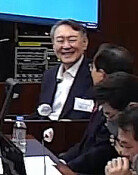North Korea Behind KAL Bombing
James R. Lilley, former U.S. Ambassador to Korea, said in his recent memoir China Hands: Nine Decades of Adventure, Espionage, and Diplomacy in Asia that the mid-air explosion of Korean Air Lines (KAL) flight 858 in 1987 was masterminded by North Korea and for this reason, the North was listed by the U.S. as one of the countries supporting terrorism.
He also argued that he met former President Chun Doo-hwan in Korea during the June uprising for democracy in 1987 to hand him a letter from then-U.S. President Ronald Reagan. He said the letter stopped the Korean president from declaring martial law.
Bombing of KAL 858
After Seoul was designated as the host city of the 1988 Olympic Games, North Korea started negotiations with South Korea, asking South Korea to co-host the event with the North. North Korea, however, was also secretly planning an attack.
When I heard the news that the Korean Airlines plane disappeared on November 29 1987, I knew the North was behind the attack.
On November 31, two suspects of the explosion were arrested by the police at the Bahrain Airport and one of them, an old man who had long been a North Korean spy, killed himself on the spot by biting the cigarette containing cyanide.
However, the other suspect, a young woman named Kim Hyun-hee, failed to commit suicide because Bahrain Superintendent Ian Henderson managed to snatch the cigarette away from her mouth. Henderson was bitten by her when he took away the cigarette and still has the mark left on his finger.
Koreas then Deputy Foreign Minister Park Soo-gil took Kim Hyun-hee to Seoul just a few days before the presidential election. The arrival of Kim put presidential candidate Roh Tae-woo in a better position than the other candidates, Kim Young-sam and Kim Dae-jung, because Roh had been strongly supporting stringent policy towards North Korea.
A senior advisor of candidate Roh told Deputy Foreign Minister Park that Roh received at least 1.5 million more votes thanks to the capture of Kim Hyun-hee.
Blocking the Declaration of Martial Law
In June 1987 when struggle for democracy was at its peak in Korea, I visited President Chun and handed him the letter from President Reagan to stop the South Korean president from declaring martial law.
When I met President Chun on June 19 at Cheong Wa Dae, he was sitting there like a stone with a stern look on his face. The letter from President Reagan contained recommendations for the Korean government to take additional measures for political development such as releasing political prisoners, punishing power-abusing police officers, and ensuring freedom of speech.
I told him the seriousness of the matter and warned that he might have to take the risk of hurting the U.S.-Korea alliance if the prime minister announced that the declaration of martial law was imminent.
In the afternoon the same day, Foreign Minister Choi Gwang-soo called and informed me that President Chun decided not to declare martial law.
Soon-Taek Kwon maypole@donga.com




![두쫀쿠가 뭐라고…영하 8도에 아이들 1시간 줄세운 어린이집 [e글e글]](https://dimg.donga.com/c/138/175/90/1/wps/NEWS/IMAGE/2026/01/09/133126969.3.jpg)
![지하철 타고 가는 북한산성…외국인도 반한 ‘K등산 맛집’[전승훈 기자의 아트로드]](https://dimg.donga.com/c/138/175/90/1/wps/NEWS/IMAGE/2026/01/10/133120824.1.jpg)

